 W
WAnjou wine is produced in the Loire Valley wine region of France near the city of Angers. The wines of region are often grouped together with the wines of nearby Saumur as "Anjou-Saumur". Along with the wines produced further east in Touraine, Anjou-Saumur make what is collectively known as the "Middle Loire" (as opposed to the "Upper Loire" which includes the wine regions of Sancerre and Pouilly-Fumé. Within the Anjou wine region are several Appellation d'origine contrôlées responsible for a broad spectrum of wines including still red, white and rosé produced with varying levels of sweetness. Extending across the Deux-Sèvres, Maine-et-Loire and Vienne départements, the generic Anjou AOC appellation and its various sub-appellations encompasses vineyards across more than 151 communes.
 W
WArbois is a commune in the Jura department in the Bourgogne-Franche-Comté region in eastern France. The river Cuisance passes through the town, which has some pretty streets lined with ancient houses. The town centres on an arcaded central square where one can sample the local wines.
 W
WBeaujolais is a French Appellation d'Origine Contrôlée (AOC) wine generally made of the Gamay grape, which has a thin skin and is low in tannins. Like most AOC wines they are not labeled varietally. Whites from the region, which make up only 1% of its production, are made mostly with Chardonnay grapes though Aligoté is also permitted until 2024. Beaujolais tends to be a very light-bodied red wine, with relatively high amounts of acidity. In some vintages, Beaujolais produces more wine than the Burgundy wine regions of Chablis, Côte d'Or, Côte Chalonnaise and Mâconnais put together.
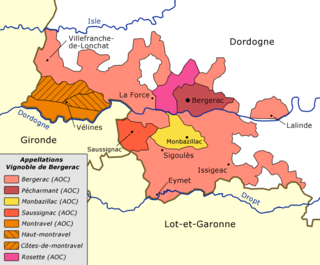 W
WThe Bergerac wine-growing region, a subregion of South West France around the town of Bergerac in the Dordogne department, comprises 93 communes. Its boundaries correspond more or less with those of the Arrondissement of Bergerac, immediately east of the Bordeaux wine region. 1,200 wine-growers cultivate an area of 12,000 hectares. The Bergerac area contains 13 Appellations d'origine contrôlées (AOCs) for red, white and rosé wines.
 W
WBordeaux wine is produced in the Bordeaux region of southwest France, around the city of Bordeaux, on the Garonne River. To the north of the city the Dordogne River joins the Garonne forming the broad estuary called the Gironde; the Gironde department, with a total vineyard area of over 120,000 hectares, is the largest wine growing area in France.
 W
WBurgundy wine is made in the Burgundy region of eastern France, in the valleys and slopes west of the Saône, a tributary of the Rhône. The most famous wines produced here—those commonly referred to as "Burgundies"—are dry red wines made from pinot noir grapes and white wines made from chardonnay grapes.
 W
WThe Chablis region is the northernmost wine district of the Burgundy region in France. The cool climate of this region produces wines with more acidity and flavors less fruity than Chardonnay wines grown in warmer climates. These wines often have a "flinty" note, sometimes described as "goût de pierre à fusil", and sometimes as "steely". The Chablis Appellation d'origine contrôlée is required to use Chardonnay grapes solely.
 W
WThe Chablis region of Burgundy is classified according to four tiers of Appellation d'origine contrôlée (AOC) designation. The top two are the crus of Chablis and include the 7 Grand cru vineyards followed by the lower Premier crus. Wines made entirely from fruit from these vineyards are entitled to list their wines as cru classé Chablis on the wine label. Below these tiers are the lower designations of basic Chablis AOC and Petit Chablis. Soil quality and hill slope play a major role in delineating the differences. Many of the Premier Crus, and all the Grand Crus vineyards, are planted along valley of the Serein river as it flows into the Yonne with the best sites located on a southwest facing slope that receives the maximum amount of sun exposure. All of Chablis' Grand Cru vineyards and many of their better Premier Cru vineyards are planted on primarily Kimmeridgean soil which is believed to impart more finesse and structure to the wines. Other areas, particularly the vast majority of Petit Chablis vineyards, are planted on slightly younger Portlandian soil.
 W
WThe Champagne wine region is a wine region within the historical province of Champagne in the northeast of France. The area is best known for the production of Champagne, the sparkling white wine that bears the region's name. EU law and the laws of most countries reserve the term "Champagne" exclusively for wines that come from this region located about 160 kilometres (100 miles) east of Paris. The viticultural boundaries of Champagne are legally defined and split into five wine-producing districts within the historical province: Aube, Côte des Blancs, Côte de Sézanne, Montagne de Reims, and Vallée de la Marne. The towns of Reims and Épernay are the commercial centers of the area. Reims is famous for its cathedral, the venue of the coronation of the French Kings and a UNESCO World Heritage Site.
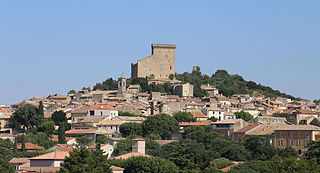 W
WChâteauneuf-du-Pape is a commune in the Vaucluse department in the Provence-Alpes-Côte d'Azur region in Southeastern France. The village lies about 3 kilometres (1.9 mi) to the east of the Rhône and 12 kilometres (7.5 mi) north of the town of Avignon. In the 2012 census the commune had a population of 2,179.
 W
WCheverny is a French wine region in the Loire Valley that makes dry white wines, light red wines and rosé wines. The area received AOVDQS status in 1973, and then AOC on 26 March 1993 when new regulatory laws were passed. The wine region is spread over 532 hectares, within 24 communes of the Loir-et-Cher department.
 W
WClérey-la-Côte is a commune in the Vosges department in Grand Est in northeastern France.
 W
WCorsica wine is wine made on the Mediterranean island of Corsica. Located 90 km west of Italy, 170 km southeast of France and 11 km north of the island of Sardinia, the island is a territorial collectivity of France, but many of the region's winemaking traditions and its grape varieties are Italian in origin. The region's viticultural history can be traced to the island's settlement by Phoceans traders in 570 BC in what is now the commune of Aléria. In the 18th century, the island came under the control of France. Following the independence of Algeria from French rule, many Algerian Pieds-Noirs immigrated to Corsica and began planting vineyards. Between 1960 and 1976 the vineyard area in Corsica increased fourfold. In 1968, Patrimonio was established as Corsica's first Appellation d'origine contrôlée (AOC). Today, Corsica has nine AOC regions including the island-wide designation Vin de Corse AOC. The majority of the wine exported from Corsica falls under the Vin de pays designation Vin de Pays de l'Île de Beauté. The three leading grape varieties of the region are Nielluccio (Sangiovese), known as the spice wine of France, Sciacarello and Vermentino.
 W
WCôte Chalonnaise is a subregion of the Burgundy wine region of France. Côte Chalonnaise lies to the south of the Côte d'Or continuing the same geology southward. It is still in the main area of Burgundy wine production but it includes no Grand cru vineyards. Like the Côte d'Or, it is at the western edge of the broad valley of the river Saône, on the rising ground overlooking the town of Chalon-sur-Saône which is about six kilometers out into the plain. To the north, across the River Dheune, lies the Côte de Beaune. To the south is the Mâconnais. The grapes of the region are predominantly Pinot noir and Chardonnay with some Aligoté and Gamay also grown in vineyards spread over a stretch of 25 kilometers long and 7 kilometers wide of undulating land in which vineyards are interspersed with orchards and other forms of farming.
 W
WThe Côte d'Or is a limestone escarpment in Burgundy, France of the same name of the department which was formed around it. It stretches from Dijon in the north to the river Dheune to the south, overlooking the valley of the Saône to the east.
 W
WThe Côte de Nuits is a French wine region located in the northern part of the Côte d'Or, the limestone ridge that is at the heart of the Burgundy wine region. It extends from Dijon to just south of Nuits-Saint-Georges, which gives its name to the district and is the regional center. Though some white and rosé wines are produced in the region, the Côte de Nuits is most famous for reds made from pinot noir. The Côte de Nuits covers fourteen communes. Six produce grand cru wines, in the central district between Gevrey-Chambertin and Nuits-Saint-Georges, with four lesser villages either side. The Grand Crus of the Cote de Nuits are some of the smallest appellations in France, less than a hectare in the case of La Romanée.
 W
WCôte de Sézanne is one of the five sub-regions of the Champagne wine region. It is south of Vallée de la Marne, Champagne, and Côte des Blancs.
 W
WThe Côte des Blancs is an area of Champagne vineyards. Located in the department of Marne, it lies south of Epernay, stretches for about 20 km, and had a vineyard area of 3,313 hectares in 2006. The Côte des Blancs is a mostly eastern-facing slope that owes its name to the color of the grape that is planted: 95% Chardonnay. Champagnes in this area include the term "blanc de blancs".
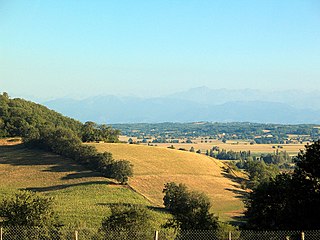 W
WCôtes de Gascogne is a wine-growing district in Gascony producing principally white wine. It is mainly located in the département of the Gers in the former Midi-Pyrénées region, and it belongs to the wine region South West France. The designation Côtes de Gascogne is used for a Vin de Pays produced in the Armagnac area. The decree of 13 September 1968 created the difference between a Vin de Pays and simpler table wine, the so-called Vin de table. The designation Côtes de Gascogne obliges the producers to respect the stricter rules and production standards, which were adopted with the decree of 25 January 1982.
 W
WJura wine is French wine produced in the Jura département. Located between Burgundy and Switzerland, this cool climate wine region produces wines with some similarity to Burgundy and Swiss wine. Jura wines are distinctive and unusual wines, the most famous being vin jaune, which is made by a similar process to Sherry, developing under a flor-like strain of yeast. This is made from the local Savagnin grape variety. Other grape varieties include Poulsard, Trousseau, and Chardonnay. Other wine styles found in Jura includes a vin de paille made from Chardonnay, Poulsard and Savagnin, a sparkling Crémant du Jura made from slightly unripe Chardonnay grapes, and a vin de liqueur known as Macvin du Jura made by adding marc to halt fermentation. The renowned French chemist and biologist Louis Pasteur was born and raised in the Jura region and owned a vineyard near Arbois.
 W
WLanguedoc is a former province of France. Its territory is now contained in the modern-day region of Occitanie in the south of France. Its capital city was Toulouse. It had an area of approximately 42,700 square kilometers.
 W
WLanguedoc-Roussillon wine, including the vin de pays labeled Vin de Pays d'Oc, is produced in southern France. While "Languedoc" can refer to a specific historic region of France and Northern Catalonia, usage since the 20th century has primarily referred to the northern part of the Languedoc-Roussillon région of France, an area which spans the Mediterranean coastline from the French border with Spain to the region of Provence. The area has around 700,000 acres (2,800 km2) under vines and is the single biggest wine-producing region in the world, being responsible for more than a third of France's total wine production. In 2001, the region produced more wine than the United States.
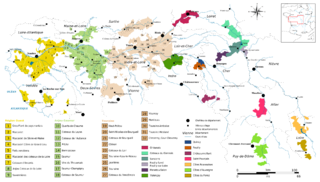 W
WThe Loire Valley wine region includes the French wine regions situated along the Loire River from the Muscadet region near the city of Nantes on the Atlantic coast to the region of Sancerre and Pouilly-Fumé just southeast of the city of Orléans in north central France. In between are the regions of Anjou wine, Saumur, Bourgueil, Chinon, and Vouvray. The Loire Valley itself follows the river through the Loire province to the river's origins in the Cévennes but the majority of the wine production takes place in the regions noted above. The area includes 87 appellations under the Appellation d'origine contrôlée (AOC), Vin Délimité de Qualité Superieure (VDQS) and Vin de pays systems. While the majority of production is white wine from the Chenin blanc, Sauvignon blanc and Melon de Bourgogne grapes, there are red wines made from Cabernet franc. In addition to still wines, rosé, sparkling and dessert wines are also produced. With Crémant production throughout the Loire, it is the second largest sparkling wine producer in France after Champagne. Among these different wine styles, Loire wines tend to exhibit characteristic fruitiness with fresh, crisp flavors-especially in their youth. The Loire Valley has a long history of winemaking dating back to the 1st century. In the High Middle Ages, the wines of the Loire Valley were the most esteemed wines in England and France, even more prized than those from Bordeaux.
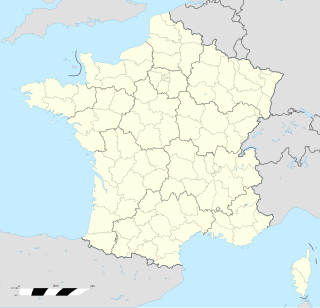 W
WMadiran is a commune in the Hautes-Pyrénées department in south-western France.
 W
WMarçon is a commune in the Sarthe department in the region of Pays de la Loire in north-western France. It is also a minor, but well-liked wine-producing area.
 W
WMontagne de Reims is one of the five sub-regions of the Champagne wine region. It is north of Vallée de la Marne, Côte de Sézanne and Côte des Blancs.
 W
WMoselle wine is produced in three countries along the Moselle river: France, Luxembourg and Germany. Moselle wines are mainly white and are made in some of the coldest climates used for commercial winemaking.
 W
WProvence (Provençal) wine comes from the French wine-producing region of Provence in southeast France. The Romans called the area provincia nostra, giving the region its name. Just south of the Alps, it was the first Roman province outside Italy.
 W
WThe Rhône wine region in Southern France is situated in the Rhône valley and produces numerous wines under various Appellation d'origine contrôlée (AOC) designations. The region's major appellation in production volume is Côtes du Rhône AOC.
 W
WThe Route des Grands Crus is the name of a tourist route situated in Burgundy, France.
 W
WSavoy is a wine region situated in the Savoy region in eastern France, and is sometimes referred to as the country of the Allobroges. It is the only alpine wine region in France, and is known for grape varieties rarely grown elsewhere, including Jacquère, Roussanne, Altesse and Gringet for white wines, and Mondeuse for reds.
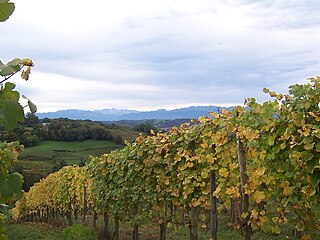 W
WSouth West France, or in French Sud-Ouest, is a wine region in France covering several wine-producing areas situated respectively inland from, and south of, the wine region of Bordeaux. These areas, which have a total of 16,000 hectares of vineyards, consist of several discontinuous wine "islands" throughout the Aquitaine region, and more or less to the west of the Midi-Pyrénées region.
 W
WVallée de la Marne is a sub-region of the Champagne wine region. It is south of Champagne and Montagne de Reims, and north of Côte de Sézanne and Côte des Blancs. The sub-region is located on the riverbanks of the Marne. Its soils are more variable than in other Champagne sub-regions, and it contains only two Grands Crus villages: Ay and Tours-sur-Marne. Pinot Meunier is the main grape variety.